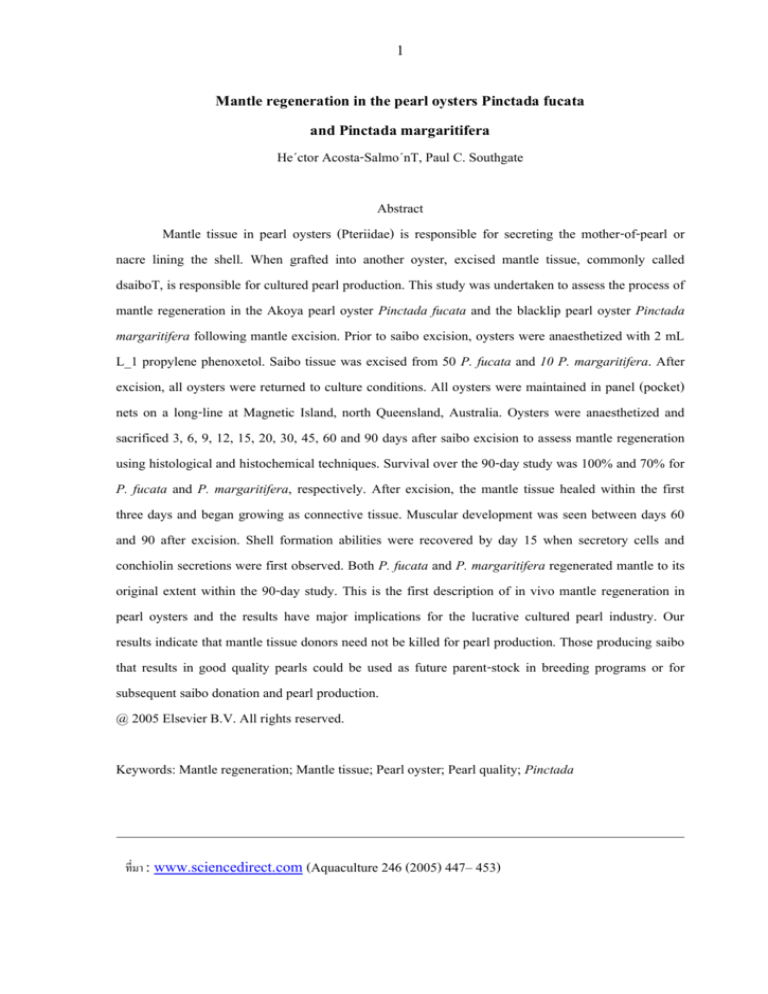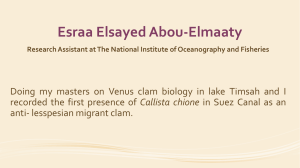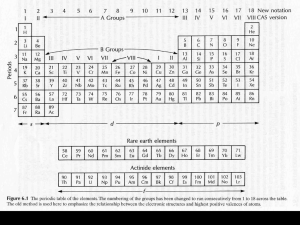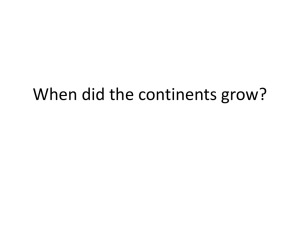
1
Mantle regeneration in the pearl oysters Pinctada fucata
and Pinctada margaritifera
He´ctor Acosta-Salmo´nT, Paul C. Southgate
Abstract
Mantle tissue in pearl oysters (Pteriidae) is responsible for secreting the mother-of-pearl or
nacre lining the shell. When grafted into another oyster, excised mantle tissue, commonly called
dsaiboT, is responsible for cultured pearl production. This study was undertaken to assess the process of
mantle regeneration in the Akoya pearl oyster Pinctada fucata and the blacklip pearl oyster Pinctada
margaritifera following mantle excision. Prior to saibo excision, oysters were anaesthetized with 2 mL
L_1 propylene phenoxetol. Saibo tissue was excised from 50 P. fucata and 10 P. margaritifera. After
excision, all oysters were returned to culture conditions. All oysters were maintained in panel (pocket)
nets on a long-line at Magnetic Island, north Queensland, Australia. Oysters were anaesthetized and
sacrificed 3, 6, 9, 12, 15, 20, 30, 45, 60 and 90 days after saibo excision to assess mantle regeneration
using histological and histochemical techniques. Survival over the 90-day study was 100% and 70% for
P. fucata and P. margaritifera, respectively. After excision, the mantle tissue healed within the first
three days and began growing as connective tissue. Muscular development was seen between days 60
and 90 after excision. Shell formation abilities were recovered by day 15 when secretory cells and
conchiolin secretions were first observed. Both P. fucata and P. margaritifera regenerated mantle to its
original extent within the 90-day study. This is the first description of in vivo mantle regeneration in
pearl oysters and the results have major implications for the lucrative cultured pearl industry. Our
results indicate that mantle tissue donors need not be killed for pearl production. Those producing saibo
that results in good quality pearls could be used as future parent-stock in breeding programs or for
subsequent saibo donation and pearl production.
@ 2005 Elsevier B.V. All rights reserved.
Keywords: Mantle regeneration; Mantle tissue; Pearl oyster; Pearl quality; Pinctada
ที่มา : www.sciencedirect.com (Aquaculture 246 (2005) 447– 453)
2
1. Introduction
The cultured pearl industry has a global retail value of around five billion US dollars per
annum (Fassler, 1997; Acosta-Salmo´n, 2004). The major species used for cultured pearl production are
the Akoya pearl oyster (Pinctada fucata Gould), the silver- or gold-lip pearl oyster (Pinctada maxima
Jameson) and the blacklip pearl oyster (Pinctada margaritifera Linnaeus) from the family Pteriidae.
Cultured round pearls are produced by grafting a round nucleus and a piece of mantle tissue or “saibo”
from a sacrificed donor oyster, into the gonad of a recipient pearl oyster. Mantle tissue naturally
secretes the mother-of-pearl (nacre) lining the inside of pearl oyster shells. Following the grafting
procedure, saibo is responsible for forming the pearlsac and for deposition of nacre onto the nucleus.
This process results in the formation of a cultured pearl, which may be harvested from the recipient
oyster after 1–2 years. The quality of cultured pearls is influenced primarily by selection of saibo from
appropriate donor oysters (Taylor, 2002). Of major importance in selecting saibo donors is the quality
of the nacre lining their shells, which is generally accepted to give an indication of resulting pearl
quality.
Generally, saibo donors are sacrificed for pearl production. However, we recently reported that
pearl oysters are able to survive the excision of a large piece of mantle and are capable of complete
regeneration of this part of the mantle and all its internal structures (Acosta-Salmo´n et al., 2004).
Regeneration is an essential process for all animals and is regarded as a mechanism by which functional
competence is recovered (Goss, 1969). For mantle tissue in pearl oysters, shell production
(periostracum, prismatic and nacreous layers) and sensory abilities are the most important functions.
A number of studies have reported on tissue regeneration in bivalve molluscs. In Macoma baltica,
Donax hanleyanus, Prothotaca staminea and Scrobicularia plana, for example, siphonal tissue is
quickly regenerated after being lost to predators or during laboratory experiments (Hodgson, 1982;
Peterson and Quammen, 1982; Pekkarinen, 1994; De Vlas, 1985; Luzzatto and Penchaszadeh, 2001).
Given the value of the cultured pearl industry and the importance of mantle tissue in
determining pearl quality (Taylor, 2002; Acosta-Salmo´n et al., 2004), it is remarkable that after more
than two centuries of studies on animal regeneration (Goss, 1969), and more than a century of studies
into cultured round pearl propagation (Saville-Kent, 1893; George, 1966), there is a complete lack of
studies on in vivo mantle regeneration in pearl oysters. We recently reported that pearl oysters, P.
fucata (Gould), are able to survive mantle excision and presented a preliminary description of the
regeneration of excised mantle tissue (Acosta-Salmo´n et al., 2004). This paper describes in detail the
progressive regeneration of excised mantle tissue in P. fucata and P. margaritifera.
3
2. Material and methods
The P. fucata and P. margaritifera used in this study were hatchery propagated (Southgate and
Beer, 1997) and maintained in suspended culture on a longline (Gervis and Sims, 1992) at Magnetic
Island, north Queensland, Australia (19812V S, 146852V E). Oysters were transferred from the culture
long-line to the adjacent laboratory where they were cleaned prior to the experiments.
Fifty P. fucata and 10 P. margaritifera were anaesthetized with 2 mL L_1 propylene
phenoxetol (Norton et al., 1996, 2000; Acosta-Salmo´n and Southgate, 2004) and sections of mantle
tissue were removed randomly from either the left or the right mantle lobe (Fig. 1) as no difference in
mantle regeneration related to shell side were recorded in a previous study (Acosta-Salmo´n et al.,
2004). After mantle excision, oysters were returned to culture conditions. All oysters were maintained
in panel (pocket) nets on a long-line at Magnetic Island for 3
Fig. 1. Photograph of P. fucata with one shell valve removed to show A (adductor muscle) and M (mantle edge). The area included within
the dotted line indicates the section of mantle tissue excised.
months during which sub-samples of P. fucata were removed at regular intervals to assess mantle
regeneration. Oysters were anaesthetized as described above and sacrificed 3, 6, 9, 12, 15, 20, 30, 45,
60 and 90 days after mantle excision when regenerating mantle tissue was sectioned for standard
histological preparation (Acosta-Salmo´n et al., 2004). Briefly, all samples were preserved in 10%
formaldehyde, dehydrated, embedded, sectioned to 5 Am and stained with H–E, MSB trichrome or
Alcian Blue-PAS (Bradbury and Gordon, 1977; Culling et al., 1985). P. margaritifera were
anaesthetized and sacrificed at the end of the three-month period and regenerated mantle tissue was
processed as described above.
4
3. Results
Survival was 100% at the end of the experiment for P. fucata. However, one P. margaritifera
died before day 20 and two further oysters died between day 60 and 90. Shells of the dead
P. margaritifera showed secretions of new prismatic layer on top of the old nacreous layer but all were
fouled in the shell margin adjacent to the wound site.
Progressive regeneration of excised mantle tissue in P. fucata is shown in Fig. 2. Rounding of
the square ends of the wound occurred within 6 days (Fig. 2b). The length of the lesion was reduced by
the anterior and posterior ends of the wound drawing closer
Fig. 2. Macroscopic progression of mantle regeneration in P. fucata at A: 3 days, B: 6 days, C: 12 days, D: 20 days, E: 30 days, and F: 60
days after mantle excision. Cz: central zone, Gl: gills, M: adductor muscle, and Mz: marginal zone: Pz: pallial zone.
together (Fig. 2c) to a point where further regeneration of the mantle was accomplished through
extension of the central zone and formation of marginal tissue at the wound site to a point where it was
continuous (Fig. 2d and e). The three lobes of the marginal zone were clearly visible by day 45 and
complete regeneration of mantle tissue to its original extent was seen by day 60 (Fig. 2f).
5
Histological analyses showed that by day 3, a healing zone packed with what are presumably
haemocytes had developed on the distal end of the mantle (Fig. 3a). As early as 6 days after mantle
excision, rudiments of the pallial artery had already formed between the muscular tissue and the healing
zone (Fig. 3b). After 9 and 12 days, elongation of both inner and outer epithelia and of new connective
tissue had taken place and the pallial artery was embedded within the connective tissue (Fig. 3c). The
marginal zone and the internal, middle and external lobes were evident 15 days after mantle excision
and secretions of conchiolin could be seen on the periostracal groove (Fig. 3d). Epithelial cells were
well defined on the inner and outer surfaces of the mantle. After 20 days the lobes had grown more
evident but there was little muscular tissue on the regenerated section of the mantle (Fig. 3e). Pigments
appeared on the marginal
Fig. 3. Histological views of mantle regeneration in P. fucata at A: 3 days, B: 6 days, C: 12 days, D: 15 days, E: 20 days, and F: 30 days
after mantle excision. Ar: artery, Cs: conchiolin secretion, Ct: connective tissue, Ee: external epitheliumm, H: presumably haemocytes, Ie:
internal epithelium, Mz: marginal zone, and Pn: pallial nerve
6
Fig. 4. Microphotograph of the internal side of the pallial zone of mantle tissue of P. fucata. A: normal tissue, B: regenerated tissue,
cce: cliliated columnar epithelium, ie: internal epithelium, lm: longitudinal muscles, and rm: radial muscles. Haematoxilin eosin–erithrosin
technique.
zone by day 30 (Fig. 3f) when there was significant muscle mass present. Elongation of the regenerated
section continued until day 60 with more muscular development (Fig. 4).
Ninety days after mantle excision, P. margaritifera showed complete regeneration of mantle
tissue to its original extent. Macroscopical observations showed a well-pigmented marginal zone of the
mantle and new nacre and prismatic secretions on the shell. Histological observations on the
regenerated mantle showed the marginal zone including the outer, middle and inner folds as well as
secretions of conchiolin; the pallial zone showing the pallial artery and the pallial nerve, and the central
zone (Fig. 5).
4. Discussion
Zero mortality of P. fucata following mantle excision in this study confirms results for the
same procedure undertaken in a preliminary study (Acosta- Salmo´n et al., 2004). There was, however,
some mortality of P. margaritifera not immediately following mantle excision but during the mantle
regeneration process. Fouling was evident on the inner shell margins of dead P. margaritifera, adjacent
to the mantle wound site. This may indicate relatively slow mantle regeneration in P. margaritifera,
which allowed fouling organisms to colonise the shells and exert further stress on the oysters. The
P. margaritifera used in this study were older than the P. fucata used. While it is possible that the age
7
of a pearl oyster influences the speed of mantle regeneration, our results may also reflect differences in
the rates of mantle regeneration between species of pearl oyster. For cultured pearl production, older
pearl oysters are
Fig. 5. Microphotograph of mantle tissue of P. margaritifera. A: normal tissue, B: regenerated tissue, cs: conchiolin secretion, ct:
connective tissue, ee: external epithelium, ie: internal epithelium, pa: pallial artery, and pn: pallial nerve. Alcian Blue-PAS technique.
frequently selected to be used as saibo donors in preference to young ones because of their slower
growth rate. It is believed that saibo tissue from such oysters secretes nacre at a slower rate resulting in
better quality pearls (Gervis and Sims, 1992).
The period immediately following mantle excision is presumably when pearl oysters are more
susceptible to mortality. However, despite a significant loss of body (mantle) tissue, the healing process
was quick enough to contain haemorrhaging and avoid death. Following excision, the mantle border of
P. fucata, at both ends of the wound, rolled inwards towards the centre of the wound. This process
reduced the size of the wound and possibly contained haemorrhaging resulting from the severed pallial
artery. Hodgson (1982) reported a similar pattern during siphon regeneration in S. plana where the
lesion width was reduced by muscular action, which provided the siphon with a mechanical seal to
prevent blood loss. Similarly, the first reaction of M. balthica to severing of the tip of the siphon was
contraction of the muscles close to the wound to prevent loss of haemolymph (Pekkarinen, 1994). The
rolling of the mantle border of P. fucata observed in this study may also be a muscular response to
contain haemorrhage and reduce the size of the wound which could then be sealed more rapidly using
smaller numbers of haemocytes and less connective tissue. Further studies on the wound sealing process
8
in pearl oysters, immediately following mantle excision, are required for a greater understanding of this
process.
Once the lesion had sealed (by day 3), regeneration of mantle tissue was rapid and complete.
Byssus production by P. fucata one week after mantle excision has previously been reported (AcostaSalmo ´n et al., 2004) and indicates that the damage caused when excising mantle tissue and the
energetic cost of the healing and regeneration process do not interfere with other body functions.
Mantle tissue surrounding the wound site in P. fucata grew in two directions: (1) ventrally towards the
shell margin from the mantle central zone forming the pallial and marginal zones and (2) laterally with
the ends of the wound healing and growing towards each other reducing the length of the lesion.
Although the mantle border of P. fucata grew back to almost its original extent within 60 days
after excision, it was not until day 30 that muscular fibres were seen within the new tissue. Functional
(secretory) abilities were presumably recovered before day 15 when conchiolin secretions and secretory
cells were seen in the newly regenerated epithelia. Mantle regeneration up to day 90 after mantle
excision in P. margaritifera was similar to that described above for P. fucata.
Mantle regeneration after excision should be an energetically expensive process for pearl
oysters. Seasonal patterns of nutrient storage and utilization have been described for many marine
bivalves and have shown that mantle tissue functions as a site for storage of nutrients in some species
(e.g. Zandee et al., 1990; Barber and Blake, 1981; Mathieu and Lubet, 1993), including pearl oysters
(Acosta- Salmo´n, 2004). Pearl oysters also show seasonal patterns of energy storage in different body
tissues related to reproductive seasonality (Saucedo et al., 2002; Acosta-Salmo´n, 2004). These
processes may provide the nutrients and energy sources required for mantle regeneration in pearl
oysters and seasonal fluctuations in nutrient availability may influence the rate of mantle regeneration.
Pekkarinen (1994) suggested that energy available for regeneration of siphonal tissue in M. balthica
may also be influenced by gonad development and nutritional circumstances.
No previous study has reported on regeneration of whole mantle tissue in pearl oysters and this
study makes a significant contribution to our knowledge of tissue regeneration in bivalve molluscs. In
commercial pearl production it is usual practice for pearl farms to obtain saibo tissue following sacrifice
of donor pearl oysters. The results of this study have shown that the saibo tissue required for cultured
pearl production can be removed from donor pearl oysters without killing them. Furthermore, excised
mantle tissue can be completely regenerated with all internal structures within three months of excision.
These results provide the basis for significant benefits to the cultured pearl industry, for example, saibo
donors producing high quality pearls can be used as future broodstock which will improve the quality of
9
general farm stock and the quality of pearls they produce. Saibo donors could also be used as future
nucleus recipients and possibly for multiple saibo donations.
Acknowledgments
This study was possible thanks to a doctoral scholarship granted by the Consejo Nacional de
Ciencia y Tecnologia (CONACyT), Mexico to the first author. The authors thank Keith Bryson, Erika
Martı´nez-Ferna´ndez and David A´ brego for technical assistance during this study.
References
Acosta-Salmo´n, H. (2004). Broodstock Management and Egg Quality of the Pearl Oysters Pinctada
margaritifera and Pinctada fucata. PhD Thesis, James Cook University, Townsville, Australia.
140 pp.
Acosta-Salmo´n, H., Southgate, P.C., 2004. Use of a biopsy technique to obtain gonad tissue from the
blacklip pearl oyster Pinctada margaritifera. Aquac. Res. 35, 93–96.
Acosta-Salmo´n, H., Martı´nez-Ferna´ndez, E., Southgate, P.C., 2004. A new approach to pearl oyster
broodstock selection: can saibo donors be used as future broodstock? Aquaculture 231,
205– 214.
Barber, B.J., Blake, N.J., 1981. Energy storage and utilization in relation to gametogenesis in
Argopecten irradians concentricus (Say). J. Exp. Mar. Biol. Ecol. 52 (2–3), 121– 134.
Bradbury, P., Gordon, K., 1977. Connective tissues and stains. In: Bancroft, J.D., Stevens, A. (Eds.),
Theory and Practice of Histological Techniques. Spottiswoode, Ballantyne Ltd., London, U.K.,
pp. 95– 112.
Culling, C.F.A., Allison, R.T., Barr, W.T., 1985. Cellular Pathology Technique, 4th Ed. Butterworths,
London, U.K. 642 pp.
De Vlas, J., 1985. Secondary production by siphon regeneration in a tidal flat population of Macoma
balthica. Neth. J. Sea Res. 19, 147–164.
Fassler, C.R., 1997. Opportunities for investing in pearl farming. World Aquaculture Society, World
Aquaculture ’97 Book of Abstracts. Seattle, WA, U.S.A, Feb. 19–23 1997.
George, D., 1966. The cultured pearl, its history and development to the present day. Aust. Gemmol. 8,
10– 26.
Gervis, M.H., Sims, N.A., 1992. The Biology and Culture of Pearl Oysters (Bivalvia: Pteriidae).
ICLARM Stud. Rev., Manila, Philippines. 49 pp.
10
Goss, R.J., 1969. Principles of Regeneration. Academic Press, New York, NY, USA. 287 pp.
Hodgson, A.N., 1982. Studies on wound healing, and an estimation of the rate of regeneration, of the
siphon of Scrobicularia plana (da Costa). J. Exp. Mar. Biol. Ecol. 62, 117– 128.
Luzzatto, D.C., Penchaszadeh, P.E., 2001. Regeneration of the inhalant siphon of Donax hanleyanus
(Philippi, 1847) (Bivalvia, Donacidae) from Argentina. J. Shellfish Res. 20, 149– 153.
Mathieu, M., Lubet, P., 1993. Storage tissue metabolism and reproduction in marine bivalves—a brief
review. Invertebr. Reprod. Dev. 23 (2–3), 123–129.
Norton, J.H., Dashorst, M., Lansky, T.M., Mayer, R.J., 1996. An evaluation of some relaxants for use
with pearl oysters. Aquaculture 144, 39– 52.
Norton, J.H., Lucas, J.S., Turner, I., Mayer, R.J., Newnham, R., 2000. Approaches to improve cultured
pearl formation in Pinctada margaritifera through use of relaxation, antiseptic application and
incision closure during bead insertion. Aquaculture 184, 1 – 17.
Pekkarinen, M., 1994. Regeneration of the inhalant syphon and siphonal sense organs of brackish-water
(Baltic Sea) Macoma balthica (Lamellibranchiata, Tellinacea). Ann. Zool. Fenn. 21, 29– 40.
Peterson, C.H., Quammen, M.L., 1982. Siphon nipping: its importance to small fishes and its impact on
growth of the bivalve Prothotaca staminea. J. Exp. Mar. Biol. Ecol. 63, 249–268.
Saville-Kent, W., 1893. The Great Barrier Reef of Australia: Its Products and Potentialities. John
Currey, O’Neil, Melbourne, Australia. 387 pp.
Saucedo, P., Racotta, I., Villarreal, H., Monteforte, M., 2002. Seasonal changes in the histological and
biochemical profile of the gonad, digestive gland, and muscle of the Calafia mother-ofpearl
oyster, Pinctada mazatlanica (Hanley, 1856) associated with gametogenesis. J. Shellfish Res.
21 (1), 127–135.
Southgate, P.C., Beer, A.C., 1997. Hatchery and early nursery culture of the blacklip pearl oyster
(Pinctada margaritifera L.). J. Shellfish Res. 16, 561– 567.
Taylor, J.J.U., 2002. Producing golden and silver south sea pearls from Indonesian hatchery reared
Pinctada maxima. World Aquaculture 2002 Book of Abstracts. Beijing, P. R. of China, Apr
23–27.
World Aquaculture Society, Baton Rouge LA, U.S.A. 754 pp.
Zandee, D.I., Kluytmans, J.H., Zurburg, W., Pieters, H., 1990. Seasonal variations in biochemical
composition of Mytilus edulis with reference to energy metabolism and gametogenesis. Neth.
J. Sea Res. 14 (1), 1– 29.









